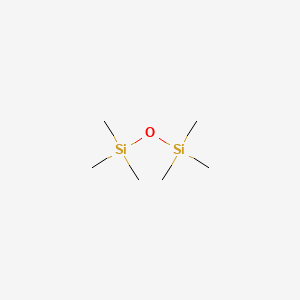Hexamethyldisiloxane
- HEXAMETHYLDISILOXANE
- 107-46-0
- Disiloxane, hexamethyl-
- Oxybis(trimethylsilane)
- HMDSO
- Create:2005-03-26
- Modify:2025-01-11

- HEXAMETHYLDISILOXANE
- 107-46-0
- Disiloxane, hexamethyl-
- Oxybis(trimethylsilane)
- HMDSO
- Fluka AG
- Hexamethyl disiloxane
- Bis(trimethylsilyl)ether
- Belsil DM 0.65
- Bis(trimethylsilyl)oxide
- Bis(trimethylsilyl) ether
- Bistrimethylsilyl ether
- Bis-trimethylsilyl oxide
- 1,1,1,3,3,3-Hexamethyldisiloxane
- KF 96L
- Bis(trimethylsilyl) oxide
- Silane, oxybis(trimethyl-
- SWS-F 221
- trimethyl(trimethylsilyloxy)silane
- OS 10
- NSC 43346
- CCRIS 1325
- HSDB 5378
- EINECS 203-492-7
- UNII-D7M4659BPU
- trimethylsilyl ether
- Dow corning 200
- D7M4659BPU
- ((CH3)3Si)2O
- AEC DISILOXANE
- DTXSID4026769
- CHEBI:78002
- MIRASIL HMS
- AI3-51466
- NSC-43346
- Silane, oxybis(trimethyl)-
- VOLASIL DM-0.65
- DTXCID406769
- SI-TEC DM 0.65
- EC 203-492-7
- SF1000N-0.65CST
- NSC43346
- MFCD00008265
- NCGC00164086-01
- Disiloxane, 1,1,1,3,3,3-hexamethyl-
- 26298-61-3
- CAS-107-46-0
- Dimethicone ~2000 (Polydimethylsiloxane)
- Dimethicone ~4000 (Polydimethylsiloxane)
- bis-tms ether
- di-tms ether
- TMS ether
- trimethylsilylether
- Dimethicone, BAN
- Dimethicone (NF)
- hexamethyl-disiloxane
- HMDO
- Dimeticone (JAN/INN)
- Polydimethylsiloxane,PDMS
- Sentry dimethicone (TN)
- DISILOXANE,HEXAMETHYL
- SCHEMBL6413
- Dow corning 200/0.65
- Hexamethyldisiloxane NMR grade
- Hexamethyldisiloxane, >=98%
- SCHEMBL3965314
- CHEMBL3184090
- HEXAMETHYLDISILOXANE [MI]
- SF1000N-0.65 cSt
- HEXAMETHYLDISILOXANE [HSDB]
- BCP11630
- HEXAMETHYLDISILOXANE [VANDF]
- trimethyl[(trimethylsilyl)oxy]silane
- Tox21_112082
- Tox21_201713
- Tox21_303119
- Dimethyl Silicone Fluid Silicone Oil
- AKOS000119927
- Hexamethyldisiloxane (analytical grade)
- 1,1,1,3,3,3-Hexamethyldisiloxane #
- NCGC00164086-02
- NCGC00257007-01
- NCGC00259262-01
- 1ST001099-100M
- DB-040758
- H0091
- H7310
- Hexamethyldisiloxane, NMR grade, >=99.5%
- NS00041276
- WLN: 1-SI-1&1&O-SI-1&1&1
- Xiameter PMX-200 Silicone Fluid 0.65 cSt
- Hexamethyldisiloxane, puriss., >=98.5% (GC)
- A801702
- Hexamethyldisiloxane, viscosity 0.65 cSt (25 C)
- Q419440
- Hexamethyldisiloxane Solution in Methanol, 100ug/mL
- J-503692
- J-802221
- BRD-K26674746-001-01-4
- F0001-0143
- Z104473212
- Hexamethyldisiloxane, for GC derivatization, >=98% (GC)
- InChI=1/C6H18OSi2/c1-8(2,3)7-9(4,5)6/h1-6H
- 29Si nuclear magnetic resonance spectrum
- Schoenflies notation
- Boiling point
- Chemical bond
- Chemical shift
- Composition
- Crystal structure
- Density
- Dielectric constant
- Excess enthalpy
- Fusion temperature
- Heat of solution
- Heat of sublimation
- Internuclear distance
- Lineshape
- Melting temperature
- Mixing enthalpy
- Molar mass
- Molecular structure
- Optical coefficient
- Phase diagram
- Phase equilibrium
- Phase transition
- Point group
- Reaction coordinate
- Refractive index
- Self-diffusion
- Spin-spin coupling constant
- Sum formula
- Surface tension
- Transition enthalpy
- Vapor pressure
- Vapor-liquid equilibrium
- Virial coefficient
- Viscosity
147.0 99.99
73.0 17.83
148.0 16.54
66.0 14.42
59.0 13.02
147.0 99.99
148.0 15.48
73.0 14.49
66.0 10.43
149.0 7.65
147 999
73 178
148 165
66 144
59 130
- Vinyltrimethylsilyloxy silicate (monomer of)
- Dimethicone (annotation moved to)
- Intermediate
- Solvent
- Intermediates
- Adhesives and sealant chemicals
- Viscosity modifiers
- Insulators
- Anti-adhesive agents
- Cleaning agent
- Surface active agents
- Terminator/Blocker
- Paint additives and coating additives not described by other categories
- Diluent
- Other
- Insulators
- Intermediate
- Solvent
- Diluent
- Other
- Lubricating agent
2019: 20,000,000 lb - <100,000,000 lb
2018: 20,000,000 lb - <100,000,000 lb
2017: 20,000,000 lb - <100,000,000 lb
2016: 20,000,000 lb - <100,000,000 lb
- Plastics Product Manufacturing
- Wood Product Manufacturing
- Construction
- All Other Chemical Product and Preparation Manufacturing
- Plastics Material and Resin Manufacturing
- Synthetic Rubber Manufacturing
- Soap, Cleaning Compound, and Toilet Preparation Manufacturing
- All Other Basic Inorganic Chemical Manufacturing
- All Other Basic Organic Chemical Manufacturing
- Paint and Coating Manufacturing
- Other (requires additional information)
- Adhesive Manufacturing


H225 (98.8%): Highly Flammable liquid and vapor [Danger Flammable liquids]
H400 (92.7%): Very toxic to aquatic life [Warning Hazardous to the aquatic environment, acute hazard]
H410 (20.1%): Very toxic to aquatic life with long lasting effects [Warning Hazardous to the aquatic environment, long-term hazard]
H411 (71.4%): Toxic to aquatic life with long lasting effects [Hazardous to the aquatic environment, long-term hazard]
P210, P233, P240, P241, P242, P243, P273, P280, P303+P361+P353, P370+P378, P391, P403+P235, and P501
(The corresponding statement to each P-code can be found at the GHS Classification page.)
Aggregated GHS information provided per 3594 reports by companies from 24 notifications to the ECHA C&L Inventory. Each notification may be associated with multiple companies.
Reported as not meeting GHS hazard criteria per 5 of 3594 reports by companies. For more detailed information, please visit ECHA C&L website.
There are 23 notifications provided by 3589 of 3594 reports by companies with hazard statement code(s).
Information may vary between notifications depending on impurities, additives, and other factors. The percentage value in parenthesis indicates the notified classification ratio from companies that provide hazard codes. Only hazard codes with percentage values above 10% are shown.
Flam. Liq. 2 (98.8%)
Aquatic Acute 1 (92.7%)
Aquatic Chronic 1 (20.1%)
Aquatic Chronic 2 (71.4%)
Patents are available for this chemical structure:
https://patentscope.wipo.int/search/en/result.jsf?inchikey=UQEAIHBTYFGYIE-UHFFFAOYSA-N
- Australian Industrial Chemicals Introduction Scheme (AICIS)Disiloxane, hexamethyl-https://services.industrialchemicals.gov.au/search-assessments/Disiloxane, hexamethyl-https://services.industrialchemicals.gov.au/search-inventory/
- CAS Common ChemistryLICENSEThe data from CAS Common Chemistry is provided under a CC-BY-NC 4.0 license, unless otherwise stated.https://creativecommons.org/licenses/by-nc/4.0/Hexamethyldisiloxanehttps://commonchemistry.cas.org/detail?cas_rn=107-46-0Hexamethyldisiloxane homopolymerhttps://commonchemistry.cas.org/detail?cas_rn=26298-61-3
- ChemIDplusHexamethyldisiloxanehttps://pubchem.ncbi.nlm.nih.gov/substance/?source=chemidplus&sourceid=0000107460ChemIDplus Chemical Information Classificationhttps://pubchem.ncbi.nlm.nih.gov/source/ChemIDplus
- DTP/NCILICENSEUnless otherwise indicated, all text within NCI products is free of copyright and may be reused without our permission. Credit the National Cancer Institute as the source.https://www.cancer.gov/policies/copyright-reuse
- EPA Chemical Data Reporting (CDR)LICENSEThe U.S. Government retains a nonexclusive, royalty-free license to publish or reproduce these documents, or allow others to do so, for U.S. Government purposes. These documents may be freely distributed and used for non-commercial, scientific and educational purposes.https://www.epa.gov/web-policies-and-procedures/epa-disclaimers#copyrightDisiloxane, 1,1,1,3,3,3-hexamethyl-https://www.epa.gov/chemical-data-reporting
- EPA Chemicals under the TSCADisiloxane, 1,1,1,3,3,3-hexamethyl-https://www.epa.gov/chemicals-under-tscaEPA TSCA Classificationhttps://www.epa.gov/tsca-inventory
- EPA DSSToxHexamethyldisiloxanehttps://comptox.epa.gov/dashboard/DTXSID4026769CompTox Chemicals Dashboard Chemical Listshttps://comptox.epa.gov/dashboard/chemical-lists/
- European Chemicals Agency (ECHA)LICENSEUse of the information, documents and data from the ECHA website is subject to the terms and conditions of this Legal Notice, and subject to other binding limitations provided for under applicable law, the information, documents and data made available on the ECHA website may be reproduced, distributed and/or used, totally or in part, for non-commercial purposes provided that ECHA is acknowledged as the source: "Source: European Chemicals Agency, http://echa.europa.eu/". Such acknowledgement must be included in each copy of the material. ECHA permits and encourages organisations and individuals to create links to the ECHA website under the following cumulative conditions: Links can only be made to webpages that provide a link to the Legal Notice page.https://echa.europa.eu/web/guest/legal-noticeHexamethyldisiloxanehttps://chem.echa.europa.eu/100.003.176Hexamethyldisiloxane (EC: 203-492-7)https://echa.europa.eu/information-on-chemicals/cl-inventory-database/-/discli/details/32082
- FDA Global Substance Registration System (GSRS)LICENSEUnless otherwise noted, the contents of the FDA website (www.fda.gov), both text and graphics, are not copyrighted. They are in the public domain and may be republished, reprinted and otherwise used freely by anyone without the need to obtain permission from FDA. Credit to the U.S. Food and Drug Administration as the source is appreciated but not required.https://www.fda.gov/about-fda/about-website/website-policies#linkingHEXAMETHYLDISILOXANEhttps://gsrs.ncats.nih.gov/ginas/app/beta/substances/D7M4659BPU
- Hazardous Substances Data Bank (HSDB)HEXAMETHYLDISILOXANEhttps://pubchem.ncbi.nlm.nih.gov/source/hsdb/5378
- Human Metabolome Database (HMDB)LICENSEHMDB is offered to the public as a freely available resource. Use and re-distribution of the data, in whole or in part, for commercial purposes requires explicit permission of the authors and explicit acknowledgment of the source material (HMDB) and the original publication (see the HMDB citing page). We ask that users who download significant portions of the database cite the HMDB paper in any resulting publications.http://www.hmdb.ca/citingDimethiconehttp://www.hmdb.ca/metabolites/HMDB0033532HMDB0033532_cms_27013https://hmdb.ca/metabolites/HMDB0033532#spectra
- New Zealand Environmental Protection Authority (EPA)LICENSEThis work is licensed under the Creative Commons Attribution-ShareAlike 4.0 International licence.https://www.epa.govt.nz/about-this-site/general-copyright-statement/
- ChEBIHexamethyldisiloxanehttps://www.ebi.ac.uk/chebi/searchId.do?chebiId=CHEBI:78002
- ChEMBLLICENSEAccess to the web interface of ChEMBL is made under the EBI's Terms of Use (http://www.ebi.ac.uk/Information/termsofuse.html). The ChEMBL data is made available on a Creative Commons Attribution-Share Alike 3.0 Unported License (http://creativecommons.org/licenses/by-sa/3.0/).http://www.ebi.ac.uk/Information/termsofuse.html
- Crystallography Open Database (COD)LICENSEAll data in the COD and the database itself are dedicated to the public domain and licensed under the CC0 License. Users of the data should acknowledge the original authors of the structural data.https://creativecommons.org/publicdomain/zero/1.0/
- EPA Chemical and Products Database (CPDat)EPA CPDat Classificationhttps://www.epa.gov/chemical-research/chemical-and-products-database-cpdat
- Haz-Map, Information on Hazardous Chemicals and Occupational DiseasesLICENSECopyright (c) 2022 Haz-Map(R). All rights reserved. Unless otherwise indicated, all materials from Haz-Map are copyrighted by Haz-Map(R). No part of these materials, either text or image may be used for any purpose other than for personal use. Therefore, reproduction, modification, storage in a retrieval system or retransmission, in any form or by any means, electronic, mechanical or otherwise, for reasons other than personal use, is strictly prohibited without prior written permission.https://haz-map.com/AboutHexamethyldisiloxanehttps://haz-map.com/Agents/5523
- NITE-CMCHexamethyldisiloxane - FY2011 (New/original classication)https://www.chem-info.nite.go.jp/chem/english/ghs/11-mhlw-0018e.htmlHexamethyldisiloxane - FY2018 (Revised classification)https://www.chem-info.nite.go.jp/chem/english/ghs/18-meti-2010e.html
- FooDBLICENSEFooDB is offered to the public as a freely available resource. Use and re-distribution of the data, in whole or in part, for commercial purposes requires explicit permission of the authors and explicit acknowledgment of the source material (FooDB) and the original publication.https://foodb.ca/aboutDimethiconehttps://foodb.ca/compounds/FDB011592
- NMRShiftDB
- SpectraBaseHexamethyldisiloxanehttps://spectrabase.com/spectrum/7wDT1JVeO3tDISILOXANE, HEXAMETHYL-https://spectrabase.com/spectrum/5VEGZs0JVZwSilane, 1,4-phenylenebis[trimethyl-https://spectrabase.com/spectrum/CasffboF7fmhexamethyldisiloxanehttps://spectrabase.com/spectrum/IMGTPSkfH9LHexamethyldisiloxanehttps://spectrabase.com/spectrum/Ikmx0CV59aBHEXAMETHYLDISILOXANEhttps://spectrabase.com/spectrum/IWPLCPaORaKDISILOXANE, HEXAMETHYL-https://spectrabase.com/spectrum/FlXQMxQjQh1Hexamethyldisiloxanehttps://spectrabase.com/spectrum/Jg28rCI8wBmHexamethylsiloxanehttps://spectrabase.com/spectrum/LTKCWdvc3NYHexamethyldisiloxanehttps://spectrabase.com/spectrum/BU72I0BB8B5Hexamethyldisiloxanehttps://spectrabase.com/spectrum/IAMixj57GLhHEXAMETHYLDISILOXANE;BIS-(TRIMETHYLSILYL)-ETHERhttps://spectrabase.com/spectrum/AJpKdZJOPeqHEXAMETHYLDISILOXANEhttps://spectrabase.com/spectrum/GyXpcBa4gNU(CH3)3SI(OSI(CH3)3);HEXAMETHYDISILOXANEhttps://spectrabase.com/spectrum/DWOOKuxUXzX(ME3SI)2O;HEXAMETHYLDISILOXANEhttps://spectrabase.com/spectrum/A1AVazgGXhgDISILOXANE, HEXAMETHYL-,https://spectrabase.com/spectrum/7pG3VITXRQeHexamethyldisiloxanehttps://spectrabase.com/spectrum/GUvTZYfI2RODisiloxane, hexamethyl-https://spectrabase.com/spectrum/5yqK49rzxdgDisiloxane, hexamethyl-https://spectrabase.com/spectrum/hUUwjHdXko
- MassBank EuropeHEXAMETHYLDISILOXANEhttps://massbank.eu/MassBank/Result.jsp?inchikey=UQEAIHBTYFGYIE-UHFFFAOYSA-N
- MassBank of North America (MoNA)LICENSEThe content of the MoNA database is licensed under CC BY 4.0.https://mona.fiehnlab.ucdavis.edu/documentation/license
- NIST Mass Spectrometry Data CenterLICENSEData covered by the Standard Reference Data Act of 1968 as amended.https://www.nist.gov/srd/public-lawDisiloxane, hexamethyl-http://www.nist.gov/srd/nist1a.cfm
- Japan Chemical Substance Dictionary (Nikkaji)
- Natural Product Activity and Species Source (NPASS)
- NCI Thesaurus (NCIt)LICENSEUnless otherwise indicated, all text within NCI products is free of copyright and may be reused without our permission. Credit the National Cancer Institute as the source.https://www.cancer.gov/policies/copyright-reuseNCI Thesaurushttps://ncit.nci.nih.gov
- NLM RxNorm TerminologyLICENSEThe RxNorm Terminology is created by the National Library of Medicine (NLM) and is in the public domain and may be republished, reprinted and otherwise used freely by anyone without the need to obtain permission from NLM. Credit to the U.S. National Library of Medicine as the source is appreciated but not required. The full RxNorm dataset requires a free license.https://www.nlm.nih.gov/research/umls/rxnorm/docs/termsofservice.htmlhexamethyldisiloxanehttps://rxnav.nlm.nih.gov/id/rxnorm/1311540
- NORMAN Suspect List ExchangeLICENSEData: CC-BY 4.0; Code (hosted by ECI, LCSB): Artistic-2.0https://creativecommons.org/licenses/by/4.0/DIMETHICONENORMAN Suspect List Exchange Classificationhttps://www.norman-network.com/nds/SLE/
- Springer Nature
- SpringerMaterialshexamethyl-disiloxanehttps://materials.springer.com/substanceprofile/docs/smsid_cqeodxlgvqzazuil
- Thieme ChemistryLICENSEThe Thieme Chemistry contribution within PubChem is provided under a CC-BY-NC-ND 4.0 license, unless otherwise stated.https://creativecommons.org/licenses/by-nc-nd/4.0/
- Wikidatahexamethyldisiloxanehttps://www.wikidata.org/wiki/Q419440
- WikipediaPristanic acidhttps://en.wikipedia.org/wiki/Pristanic_acidHexamethyldisiloxanehttps://en.wikipedia.org/wiki/Hexamethyldisiloxane
- Wiley
- PubChem
- Medical Subject Headings (MeSH)LICENSEWorks produced by the U.S. government are not subject to copyright protection in the United States. Any such works found on National Library of Medicine (NLM) Web sites may be freely used or reproduced without permission in the U.S.https://www.nlm.nih.gov/copyright.htmlhexamethyldisiloxanehttps://www.ncbi.nlm.nih.gov/mesh/67015917
- GHS Classification (UNECE)GHS Classification Treehttp://www.unece.org/trans/danger/publi/ghs/ghs_welcome_e.html
- Consumer Product Information Database (CPID)LICENSECopyright (c) 2024 DeLima Associates. All rights reserved. Unless otherwise indicated, all materials from CPID are copyrighted by DeLima Associates. No part of these materials, either text or image may be used for any purpose other than for personal use. Therefore, reproduction, modification, storage in a retrieval system or retransmission, in any form or by any means, electronic, mechanical or otherwise, for reasons other than personal use, is strictly prohibited without prior written permission.https://www.whatsinproducts.com/contents/view/1/6Consumer Products Category Classificationhttps://www.whatsinproducts.com/
- EPA Substance Registry ServicesEPA SRS List Classificationhttps://sor.epa.gov/sor_internet/registry/substreg/LandingPage.do
- MolGenieMolGenie Organic Chemistry Ontologyhttps://github.com/MolGenie/ontology/
- PATENTSCOPE (WIPO)SID 403378611https://pubchem.ncbi.nlm.nih.gov/substance/403378611






